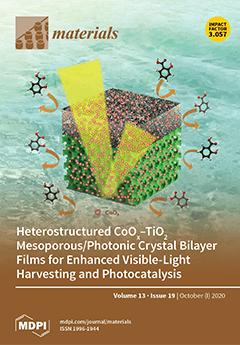New polycrystalline SrMo
1−xM
xO
4−δ (M = Fe and Cr) scheelite oxides have been prepared by topotactical oxidation, by annealing in air at 500 °C, from precursor perovskites with the stoichiometry SrMo
1−xM
xO
3−δ (M = Fe and Cr). An excellent reversibility between the oxidized Sr(Mo,M)O
4−δ scheelite and the reduced Sr(Mo,M)O
3−δ perovskite phase accounts for the excellent behavior of the latter as anode material in solid-oxide fuel cells. A characterization by X-ray powder diffraction (XRD) and neutron powder diffraction (NPD) has been carried out to determine the crystal structure features. The scheelite oxides are tetragonal, space group
I41/a (No. 88). The Rietveld-refinement from NPD data at room temperature shows evidence of oxygen vacancies in the structure, due to the introduction of Fe
3+/Cr
4+ cations in the tetrahedrally-coordinated B sublattice, where Mo is hexavalent. A thermal analysis of the reduced perovskite (SrMo
1−xM
xO
3−δ) in oxidizing conditions confirms the oxygen stoichiometry obtained by NPD data; the stability range of the doped oxides, below 400–450 °C, is lower than that for the parent SrMoO
3 oxide. The presence of a Mo
4+/Mo
5+ mixed valence in the reduced SrMo
1−xM
xO
3−δ perovskite oxides confers greater instability against oxidation compared with the parent oxide. Finally, an XPS study confirms the surface oxidation states of Mo, Fe, and Cr in the oxidized samples SrMo
0.9Fe
0.1O
4-δ and SrMo
0.8Cr
0.2O
4-δ.
Full article






